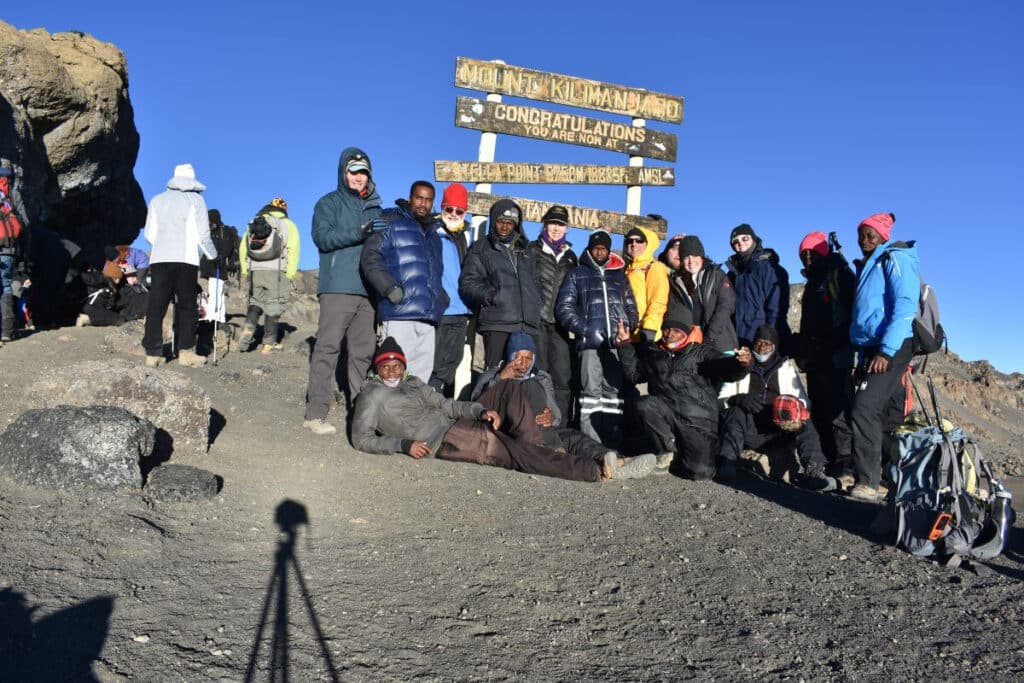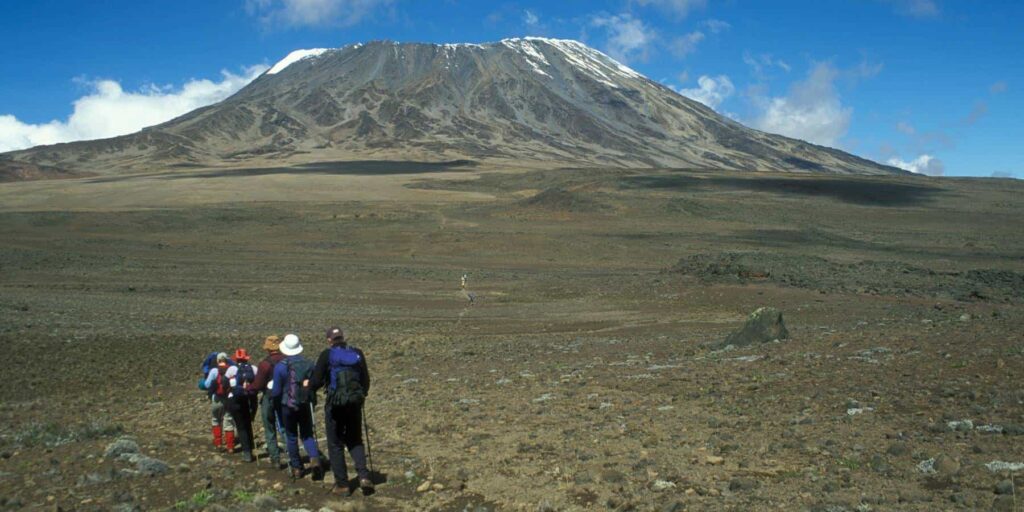The Marangu route is the original path up Mount Kilimanjaro and the only one that offers accommodation in huts instead of tents. While the trail isn’t particularly steep, its acclimatization profile is less favorable, leading to a lower summit success rate. Here’s a detailed day-by-day breakdown of the route.

The Marangu route is one of the oldest and most popular trails up Mount Kilimanjaro. It is often referred to as “the” Coca-Cola” route” due to its hut accommodations and the availability of soft drinks along the way.
The Marangu route approaches Kilimanjaro from the southeast and is relatively gentle, with minimal steep climbs. However, its poor acclimatization profile often leads to altitude sickness, resulting in a lower summit success rate than other routes.
The 72-kilometer (45-mile) route can be completed in five or six days. It ascends Kilimanjaro via the southeastern slope and is the only trail offering hutted accommodation. While camping is an option on this route, most trekkers opt for the huts.
Because of the hut system, Marangu trekkers use the same path for ascent and descent, making it the route with the least varied scenery. Despite this, the landscapes you encounter—rainforest, moorland, alpine desert, and the Arctic summit—are still stunning and diverse.
The six-day Marangu route includes an ascent and descent profile that aids acclimatization. In contrast, the five-day route is a steady incline and doesn’t offer the same acclimatization advantage we’ll discuss further. “The option”, climb high sleep”, and “p lo” approach improves the chances of reaching the summit.

While some tour operators offer a five-day Marangu route itinerary, we believe this allows insufficient time for proper acclimatization and poses unnecessary risks. Instead, we recommend the more responsible six-day Marangu itinerary, which we outline below.

On Day 1 of your Kilimanjaro trek, you hike through dense rainforest. However, at some point, there are openings in the vegetation that offer views of the farmlands that cover the mountain’s base outside of the Kilimanjaro National Park. The day’s trail ends at Mandara Hut, where you overnight.

The second day’s trek begins in the lush rainforest, but as you ascend, the scenery transitions to the unique vegetation of the moorland zone. Along the way, you’ll catch stunning views of the snowcapped Kibo and Mawenzi peaks. After hiking for six to eight hours, you’ll arrive at Horombo Hut, your resting place for the night.

Day three involves a two-part trek: ascending to Mawenzi Ridge and returning to Horombo Hut. This schedule follows the “clim” high, sleep low” str” tags, which help the body adjust to the altitude and aid in acclimatization.
The trek begins with a climb from Horombo Hut into the heath zone of Mount Kilimanjaro. You’ll run through this striking landscape until you reach the horseshoe-shaped Mawenzi Ridge, the highest point of this section.

When you reach Mawenzi Ridge, you take in the breathtaking views before returning to Horombo Hut for another night. As mentioned, climbing high and sleeping low is a vital acclimatisation strategy.

Today’s trek takes you across the Saddle, a vast and barren stretch of alpine desert connecting the Mawenzi and Kibo craters. This five-mile expanse of rocky terrain offers dramatic views and a sense of isolation as you make your way toward Kibo Hut, where you’ll spend the night in preparation for the summit push.

Today’s journey consists of the challenging summit climb and the descent back to Horombo Hut for the night.
Your guide will wake you around midnight to prepare for the summit attempt. This is often the most mentally and physically demanding day of the Kilimanjaro adventure.
The trek begins with a northwest ascent through the dark, cold night. After about six hours, you’ll reach Stella Point, where a breathtaking sunrise will greet you. From there, it’s another hour-long trek along a snow-covered trail to Uhuru Peak, standing at 5,895 m (19,341 ft) — the highest point in Africa!
Having achieved this incredible feat, you’ll begin descending to Horombo Hut for some much-needed rest.

After celebrating your achievement at the summit, you’ll begin the long descent to Horombo Hut for the night. After the earlier ascent, this trek section is physically demanding, but the decrease in altitude will be a welcome relief.
Having spent 12 to 15 hours on the trail, you’ll be ready for a well-earned rest. Trust us — sleep will come quickly tonight!

Your final day on Kilimanjaro takes you on a scenic descent through the rainforest to the mountain’s base. At Marangu Gate, your driver will be waiting to greet you. It’s time to celebrate your incredible achievement with a well-earned drink and a memorable dinner!
You may have thought the Marangu route was the cheapest, easiest, and most popular way to climb Kilimanjaro. However, this perspective is outdated, and we view it quite differently. The Marangu route is one of our least favoured Kilimanjaro climbing paths. While it offers rewarding views from the Saddle, a high-altitude desert, it’s less scenic than other routes since you ascend and descend via the same trail.
One key feature of the Marangu route is its unique hut accommodation on Kilimanjaro. Unlike other routes that require camping, the Marangu route provides dormitory-style huts with basic amenities and mattresses. This makes it a popular option for budget operators who may not have camping equipment available. We recommend the Marangu route only if you prefer not to camp during your climb.

The Marangu route offers less scenery variety than other Kilimanjaro routes as you ascend and descend along the same path.
However, the scenery is still stunning! At the summit, you pass through lush rainforests, expansive moorlands, high-altitude deserts, and the arctic landscape. While other routes may offer more diverse landscapes due to different ascent and descent paths, the Marangu route still provides a beautiful and memorable experience.

The Marangu route is often considered the “easiest” Kilimanjaro route, but this reputation is somewhat misleading. While it offers amenities like hut accommodation, is relatively shorter, and avoids the steep Barranco Wall, it requires climbers to ascend quickly. This rapid ascent increases the risk of poor acclimatization, a significant reason many trekkers fail to reach the summit.
The Marangu route has one of the lowest summit success rates of all seven Kilimanjaro routes. While official statistics are unavailable, the average success rate across all Kilimanjaro operators for this route is around 50%, meaning only about half of those who attempt the climb make it to Uhuru Peak.

The Marangu route is one of the most popular paths to the summit of Kilimanjaro. Its gradual slope and straightforward path make climbing easier than other routes. The route is also ideal for those who prefer not to camp, as it offers hut accommodations instead of tents. Additionally, the trek can be more affordable since fewer porters are needed—camping equipment isn’t required.
However, this popularity has a downside: the Marangu route can be crowded, especially during peak seasons. If you’re looking for a quieter experience, this may not be your route. For a more serene and less trafficked trek, consider the Northern Circuit instead.

The Marangu route is the only Kilimanjaro route that offers hut accommodation, though camping is also available at the hutted campsites.
Mandara and Kibo Huts each provide 60 bunk beds, while Horombo Hut has 120. While sleeping bags are not provided, mattresses and pillows are provided at the huts. It’s a good idea to check with your tour operator to see if they can supply a winter sleeping bag for your trek.

The huts along the Marangu route feature communal dining halls and washrooms, although the quality varies. The lower huts have running water and flushing toilets, while the Kibo Hut has more basic facilities, including bucket water and long-drop toilets.
After learning about the Marangu route, we suggest reading The Seven Different Kilimanjaro Routes: The Pros and Cons of Each to compare it with others in terms of difficulty, summit success rate, and other factors.

Head of written content